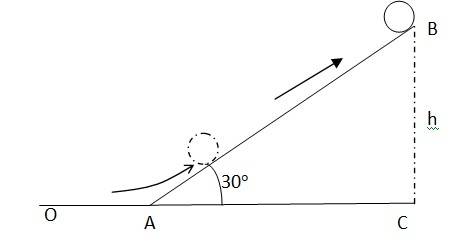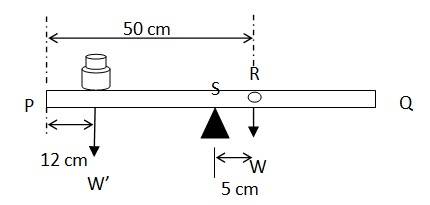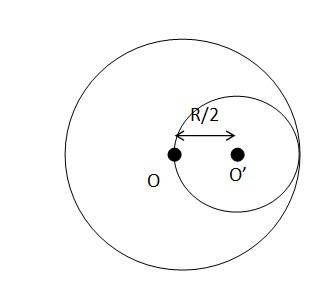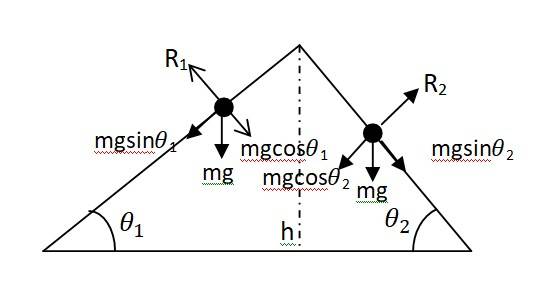Class 11th
Get insights from 8k questions on Class 11th, answered by students, alumni, and experts. You may also ask and answer any question you like about Class 11th
Follow Ask QuestionQuestions
Discussions
Active Users
Followers
New answer posted
6 months agoContributor-Level 10

Initial velocity of the cylinder, v = 5 m/s
Angle of inclination, = 30
Height reached by the cylinder = h
Energy of the cylinder at point A:
KE rot + KEtrans
(1/2) I + (1/2) m
Energy of the cylinder at point B = mgh
Using the law of conservation of energy
(1/2) I + (1/2) m = mgh
Moment of inertia of the solid cylinder I = (1/2) mr2
Hence (1/2)(1/2)mr2 + (1/2) m = mgh
We also know v = r
(1/4)m + (1/2) m = mgh
(3/4) = gh
h = (3/4)( = (3/4)(25/9.81) = 1.91 m
In Δ ABC, = , AB = BC / = 3.82 m
Hence the
New answer posted
6 months agoContributor-Level 10
5. (i) A = {1, 3, 5, 7, …}
(ii) B = {0,1,2,3,4} (as =4.5 and = –0.5)
(iii) x2 ≤ 4
x2 ≤ 22
x ≤ ± 2
So, C = {–2, –1,0,1,2}
(iv) D = {L, O, Y, A}
(v) E = {February, April, June, September, November}
(vi) F = {b, c, d, f, g, h, j}
New answer posted
6 months agoContributor-Level 10
Mass of the oxygen molecule, m = 5.30 * 10-26 kg
Moment of inertia, I = 1.94*10-46 kg m2
Velocity of the oxygen molecule, v = 500 m/s
the separation of atoms in oxygen molecule = 2r.
the mass of each oxygen atom = (m/2)
Moment of inertia I can be calculated as I = (m/2)r2 + (m/2)r2
hence r =
r = sqrt (1.94*10-46 / 5.30 * 10-26 = 6.05 x 10-11
It is given that KErotation = KEtranslation
(1/2)I = (2/3) (1/2)mv2
= (v/r)
= 6.8 x 1012 rad/s
New answer posted
6 months agoContributor-Level 10
Radius of the hoop, r = 2 m, mass of the hoop, m = 100 kg, velocity of the hoop, v = 20 cm /s = 0.2 m/s
Total energy of the hoop = Translational KE + Rotational KE = m +
Moment of inertia about the centre, I = mr2
So the total energy = m +
Since v = r we get
Total energy = m + =
Required work to be done = 100 x 0.2 x 0.2 J = 4 J
New answer posted
6 months agoContributor-Level 10
4. (i) {3,6,9,12}= {3 * 1, 3 * 2, 3 * 3, 3 * 4}
= {x : x = 3n, n is natural number and 1≤ n ≤ 4}
(ii) {2,4,8,16,32}= {21, 22, 23, 24, 25}
= {x : x = 2n, n is natural number and 1 ≤ n ≤ 5}
(iii) {5,25,125,625}= {51, 52, 53, 54}
= {x : x = 5n, n is natural number and 1 ≤ n ≤ 4}
(iv) {2,4,6, }= {2 * 1, 2 * 2, 2 * 3, …}
= {x : x = 2n, n is a natural number}
(v) {1,4,9, …, 100}= {12, 22, 32, …, 102}
= {x : x = n2, x is a natural number and 1 ≤ n ≤ 10}
New answer posted
6 months agoContributor-Level 10
(a) Let the mass of the sphere = m
Height of the plane = h
Velocity of the sphere at the bottom of the plane = v
At the top of the plane, the total energy of the sphere = potential energy = mgh
At the bottom of the plane, the sphere has both translational and rotational energies.
Hence, total energy = (1/2)mv2 + (1/2)I
Using the law of conservation of energy, we can write: (1/2)mv2+ (1/2)I = mgh …(1)
For a solid sphere, the moment of inertia, I = (2/5)mr2
The equation (1) becomes (1/2)mv2 + (1/2)( (2/5)mr2 = mgh
(1/2) v2 + (1/5)r2 = gh
From the relation v = , we get
(1/2) v2+ (1/5) v2= gh
v =
Since v depends on
New answer posted
6 months agoContributor-Level 10

Mass of the meter stick = W
Mass of each coin = 5 g
When the coins are placed 12 cm away from the end P, the centre of mass gets shifted by 5 cm from point R towards the end P. The centre of mass is located at a distance of 45 cm from point P.
The net torque will be conserved for rotational equilibrium about point R,
10 x (45-12) – W' (50-45) = 0
W' = (10 x 33)/5 = 66 g
New answer posted
6 months agoContributor-Level 10
Radius of the original disc = R


Mass of the smaller disc = = (1/4) = M/4
Let O and O' be the respective centers of the original disc and the cut out disc respectively. As per the definition of the centre of mass, the centre of mass of the original disc is supposed to be concentrated at O, while that of the smaller disc is supposed to be concentrated at O'.
It is given, OO' = R/2
After the smaller disc has been cut from the original, the remaining portion is considered to be a system of two masses. The two masses are
M – concentrated at O and M/4 concentrated at O'
Let x be the distance through which the centers of mas
New answer posted
6 months agoContributor-Level 10
Angular speed of the rotor, = 200 rad/s
Torque, = 180 Nm
Power required, P = x = 180 x 200 = 36 x103 W = 36 kW
New answer posted
6 months agoContributor-Level 10
Mass of the hollow cylinder, m = 3 kg
Radius of the hollow cylinder, r = 40 cm = 0.4 m
Applied force, F = 30 N
The MI of the hollow cylinder about its axis,
I = = 3 x 0.4 x 0.4 = 0.48 kgm2
Torque, = 30 x 0.4 = 12 Nm
For angular acceleration , torque is given by
= I x or
/ I = 12 / 0.48 = 25 rad/s
Linear acceleration = r x = 0.4 x 25 = 10 m/s2
Taking an Exam? Selecting a College?
Get authentic answers from experts, students and alumni that you won't find anywhere else
Sign Up on ShikshaOn Shiksha, get access to
- 65k Colleges
- 1.2k Exams
- 679k Reviews
- 1800k Answers

